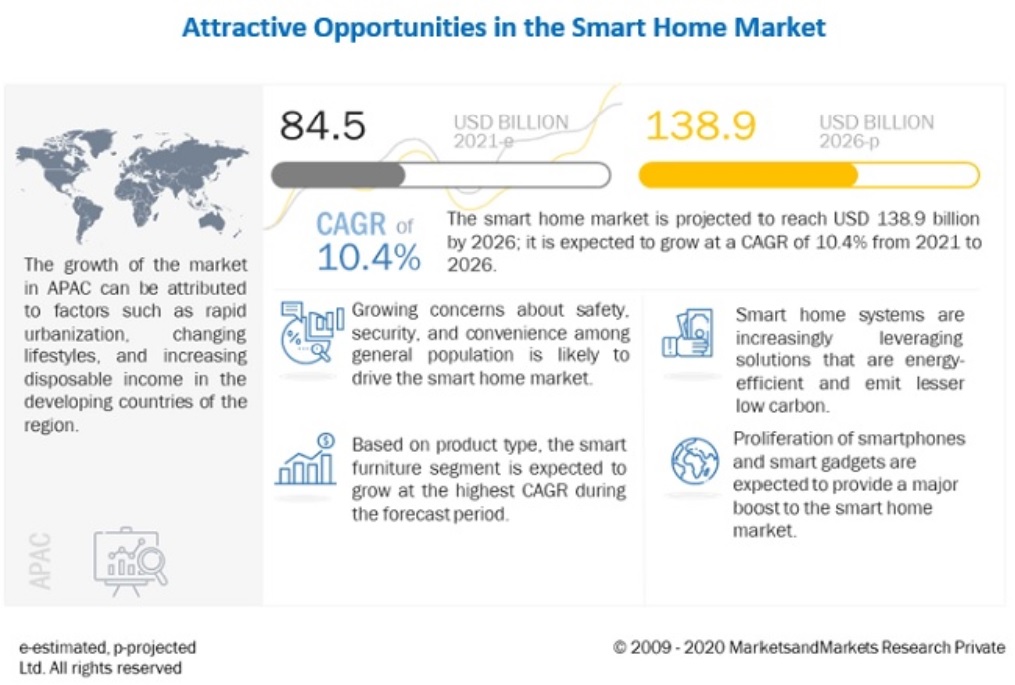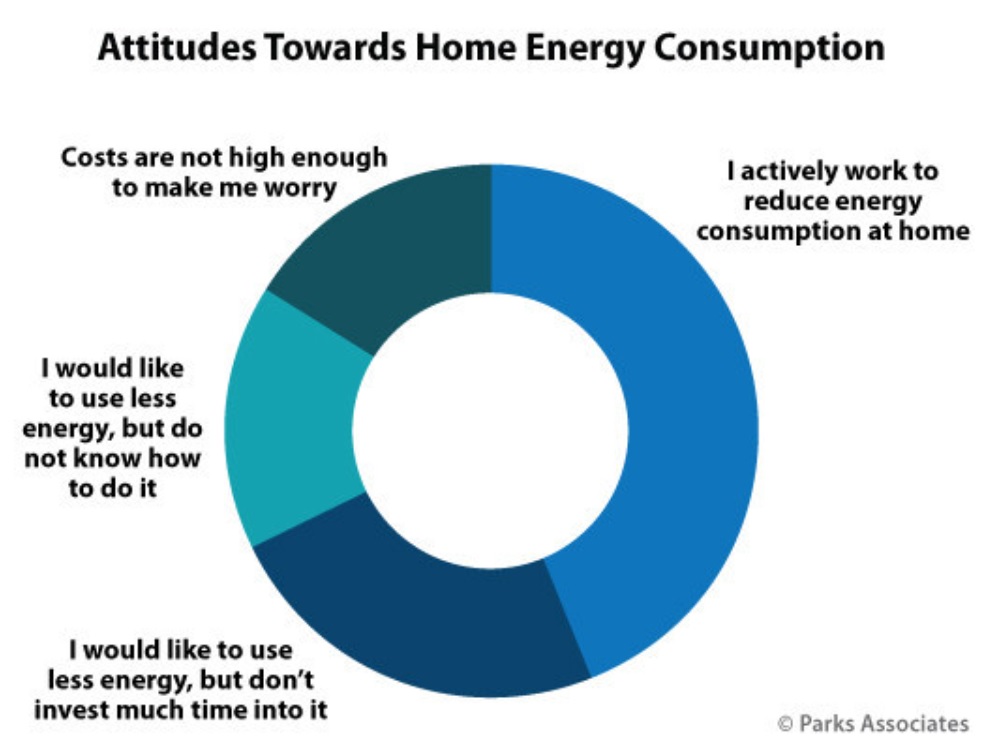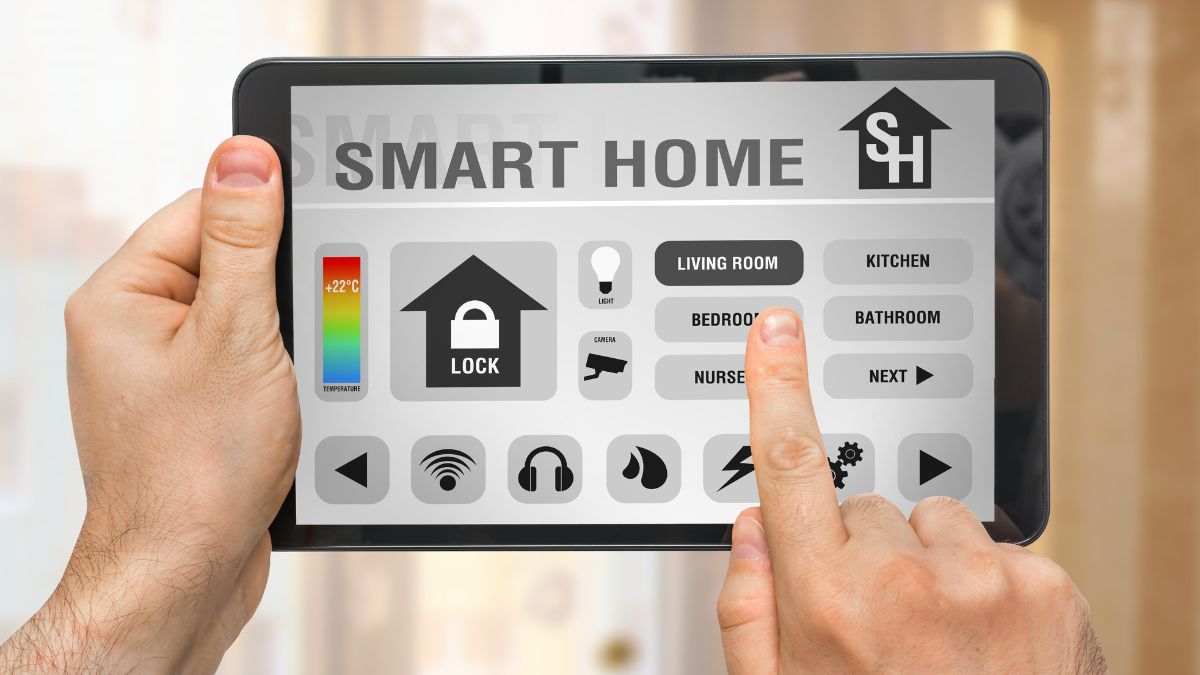Is the future of smart-home control local or centralized—or is there a third option?
Residential homes will change more during the next couple of decades than they did during the hundreds of years preceding them. This is according to Jonathan Collins, research director at ABI Research, who explains further by saying that homes will expand in capability, function, and activity, thereby reflecting the wider global needs of the planet, economies, societies, and individuals. The homes themselves will not do this on their own, of course; it’ll be the people living within them who drive the change, and they will do so primarily because smart homes offer convenience and more control over energy usage. Having more insight into and control over energy usage can lead to lower energy costs and a reduced carbon footprint—things businesses and consumers are caring more about due to rising energy costs and climate change.

The trend toward sustainability is boosting markets like smart home, which MarketsandMarkets projects will grow from $84.5 billion in 2021 to $138.9 billion in 2026. It’s not just convenience and a desire for more sustainable living that’s driving connectivity in residential home environments, either. The smart-home ecosystem has developed from a niche market to a mainstream one in the past few decades, says Collins, and along with that maturation has come changes in the accessibility and affordability of smart-home devices. There’s also been a shift from local to centralized control, but the debate rages on—should smart homes leverage cloud or edge, or is there a third option?
This Moment in Smart Home Evolution
Collins says smart home has traditionally been about home security, but that’s changing. “The popularity of devices such as smart thermostats and the ability of these connected smart home products to support greater efficiency and intelligence in the use of energy heating and cooling the home has driven smart home as a way for consumers and utilities and other players to leverage improved energy management,” he explains. “We will see more and more applications and devices leveraging smart-home understanding of the home environment to drive down wastage and inefficiencies in energy and other resource consumption.”
6 Types of Future Smart Homes
Jonathan Collins of ABI Research says emerging technologies and functionalities will help create the following six types of smart homes:
- The Sentient Home: The smart home automatically adjusts and changes elements within the home to suit a range of criteria, including individual presence, preferences, efficiency, time of day, type of activity, and more.
- The Cooperative Home: The smart home exchanges data and demands as part of a wider network of homes integrated into the local neighborhood/city/region/nation to manage, control, use, and share resources efficiently as part of wider systems.
- The New Lifestyle Home: Smart-home management and capabilities will support simple and flexible changes in the use of spaces in the home to support a growing number of activities within the home, even while the home footprint reduces.
- The Home as a Business: Smart-home control and management enable and support additional revenue-generating applications that monetize home activities.
- The Low-Impact Home: Smart-home control over the selection, generation, delivery, consumption, and disposal of goods and services within the home drives pushes toward zero environmental impact.
- The Marketplace Home: The smart home is the critical mediation point through which industries and services must present, establish, nurture, maintain, and grow consumer spending.
Mitch Klein, executive director of the Z-Wave Alliance, similarly says in the early days of smart home, there was a divide between home entertainment and home security. “When first introduced, the two systems did not overlap and did not speak to each other,” Klein says. “Users had one system for home entertainment and one system for security. Since then, the industry has been working to close that gap and connect all systems within the home together. The smart home of today has the capability to have multiple systems communicate and work together. There’s been a significant shift in how we think about these solutions. Today, you’re not just talking about the door lock but rather the entire security system of your home. A smart door lock today can tell the entire system to take a myriad of actions, turn on/off lights, set temperature, arm/disarm—all of these components are far more connected than they used to be.”
As consumers adopt more devices and more types of devices and systems, have smart homes become more complex? Yes, but also no. Paul Williams, chief product officer at Nice/Nortek Control, says without a doubt, homes are becoming more complex. “There’s a device for nearly everything you can ask for in a home—from smart thermostats to doorbells, lighting, security, audio/video, and more,” Williams says. “People want to do it all—control their entertainment rooms, secure their home, protect their loved ones, and manage their energy use inside. But with each addition comes more complication and fragmentation—everyone has different apps for everything, but no one wants to have ‘umpteen’ different apps to utilize for control.”
Frank Saldana, a researcher for Parks Associates, suggests the concept of complexity is not straightforward in smart home, though. “More device offerings and connected ecosystems are present in the market now compared to a decade ago,” Saldana says. “However, the ability of device(s) to work in tandem with other devices—even in different ecosystems—has also increased. Initiatives like Matter … that are aimed at bridging remaining gaps in interoperability and device compatibility are being committed to by tech giants and smaller developers alike and will help simplify consumers’ experience as shoppers and users of smart-home devices.”
AI (artificial intelligence) technologies are driving other trends in the space, including improvements in video and audio analytics, facial recognition, and voice assistants. “Facial recognition allows smart cameras, doorbells, alarms, and other devices the ability to recognize familiar faces—family, friends, etc.—as opposed to intruders/strangers, which results in fewer false alarms,” Saldana adds. “Alexa Hunches, for example, can recommend smart device actions to their users based on past usage and trends. Contextual awareness and event-based recording have become more common in smart cameras and other audio devices.”
Brad Arthur, product manager for SmartHome, says one of the biggest smart-home trends during the past few years has been the adoption and use of voice assistants like Apple’s Siri, Google Assistant, and Amazon’s Alexa. “We see this trend continuing well into the next five years as voice assistants and the AI driving them improves even further,” he says. “Voice control for the smart home has been the biggest innovation the industry has seen since the innovation of wireless smart-home devices. It is so much more convenient to control your smart home via voice rather than picking up your smartphone, opening an app, and pressing a ‘button.’”
Another force impacting the smart-home space is the massive move to remote work due to the COVID-19 pandemic. Christy Roth, director of offer management, home, and distribution software and devices at Schneider Electric, says the past couple of years have brought a shift in consumer needs. “With more people working from home, their reliance on resilient home energy has become a greater priority,” she explains. “For them, a power outage is more than an inconvenience that keeps them from watching their favorite show on Netflix—it could prevent that employee from joining a virtual meeting, submitting a project, or making a critical deadline. They also recognize that their increase in time spent at home is increasing their energy use and, in turn, their costs and carbon footprint. As the desire for more sustainable energy models grows, consumers are seeking new technologies coming to market, transitioning from smart-home convenience to a greater focus on smart, sustainable home innovation.”
As more people seek to connect their homes, there is still the question of how. The industry is moving toward a cloud model, but some say local is where it’s at, while others say a balance between cloud and edge computing is the best model for smart home going forward.
Cloud, Edge, or Option 3?
Razib Iqbal, associate professor of computer science at Missouri State University, says cloud is the path the industry is set upon. “We can see this by the rise in internet-enabled devices and the success of various cloud platforms like AWS (Amazon Web Services),” Iqbal says. “There are many reasons for this. I think one of the largest is convenience. It is simpler to allow an external setup to handle all the heavy lifting, lowering the end device cost. The biggest downside, however, is connectivity. A system that relies on the cloud is broken if connectivity is lost. One solution might be edge intelligence, where selective data is processed at the edge—i.e., in the smart home where sensors and devices are deployed. Depending on processing requirements, collected data is either processed in the device or the hub in the periphery of the home network. Only a subset of data is transmitted to a remote server. Moreover, sensitive information can be processed at the edge, allowing only non-sensitive information to be sent to the cloud for further processing.”
Renita Murimi, associate professor of cybersecurity at the University of Dallas, says local and centralized smart-home controls each has its upsides. “Within the context of smart homes, cloud-based applications give users the benefits of convenience,” she explains. “Users are not responsible for data storage or software updates and are able to access the data from any location. As an example, someone left on a vacation and left a light on in the closet will be able to turn it off from anywhere outside their home. This applies to countless other scenarios of access to devices and data. However, this also means that if the cloud is compromised, suddenly personal data is available freely on the internet and/or on the dark web and offers attackers a new threat vector to exploit. With local storage, since the data storage, applications/software, and hardware are on-premises with limited remote access, the attack surface is greatly reduced, but so is the convenience of remote access.”
Murimi stresses the importance of factoring security into the design and development of smart-home devices and applications. “The amount of data that we generate from within a home is enormous and includes information about our habits, lifestyles, and preferences,” she explains. “This data is of significant benefit to industry, as companies develop products to fit our lifestyles. It is also important to attackers, who look for any available weak link to gain access to devices and applications and then exploit the data.”
SmartHome’s Arthur says local should win in the debate between edge and cloud control of smart homes, due to factors such as security, privacy, and reliability. “However, the entire industry is moving to cloud,” he says. “With the popularity of Alexa, Google Home, and Apple HomeKit—all cloud services—increasing, in the near future this will become the dominant way to control your smart home, if it has not already.”
But are cloud and edge the only options? The third option is a blend of local and centralized control, and many experts believe this is the way forward and truly the best scenario for consumers. Nice/Nortek Control’s Williams says there’s a place for both cloud and edge in smart home. “The industry has gone from everything local to everything in the cloud before realizing that what we need is a mixed mode,” he explains. “Some things still definitely need to happen locally because it requires a fast speed. Despite quick internet, we can still encounter lags and latency. As we work to get more people connected in the world, a lot of people can still lose connection. We, as an industry, have to decide and understand what technology is critical. If you need to control an alarm system or a door lock, those are types of tech that can’t rely on just a cloud system to operate. They need a local connection. However, even local systems need cloud capabilities to be controlled remotely from any location when not in the space physically. It’s all about achieving an ideal balance.”
Similarly, Z-Wave’s Klein says the secret to success for the smart home will be achieving ideal balance between what’s capable of being processed locally, which provides a better user experience, and what needs to be processed in the cloud. “Local control is critical for minimizing latency and downtime. Today’s customers want immediate response when they trigger their smart-home devices and systems,” he says. “When you rely solely on the cloud, that initial command has further to travel, thus introducing latency and vulnerability. However, cloud access is what is needed for users to be able to access their home remotely and provide critical firmware updates that add features and enhance performance.”
Saldana of Parks Associates breaks it down by saying edge processing trades price for performance, while cloud processing trades privacy for performance. “Edge computing has lower latency than cloud computing, but (it) also runs the risk of complete data loss should a device fail. Cloud computing features potentially more inexpensive devices, but efficiency of said devices is dependent on the functionality of the cloud, which can fluctuate,” he explains. “Consumers also have privacy concerns regarding the sharing of their device information as it moves to and from the cloud. A hybridized approach to smart devices has gained traction in recent years, as developers have tried to create technology that leverages the advantages of both edge and cloud processing.”
Sandboxing is a mechanism that separates data in local and cloud storage depending on which data can be more efficiently processed locally or in cloud. “Essentially, private information can be processed locally by the device, while software updates and other performance metrics can be handled by the cloud,” concludes Saldana. “However, devices that combine edge and cloud connections feature the weaknesses of both approaches, including the combination of the upfront cost for edge capabilities and the recurring charges associated with cloud subscription services.”

Whether consumers choose an edge, cloud, or sandboxing approach, Parks Associates reports 44% of U.S. internet households are taking active steps to reduce their energy consumption at home, and smart-home technologies can help consumers accomplish their goals. Schneider Electric’s Roth says as society faces the inevitability of disabled power grids and extreme weather threats, consumers and businesses need tools to help them better understand where their energy comes from and how much they’re using to contribute to a more resilient power grid. “A recent report found that smart devices will play a major role in the shift to clean energy and the fight to stop climate change, including smart appliances that make homes more energy efficient,” she says. “The same report found that we need to cut our pollution in half by 2032 and meeting that goal will mean making changes in the way we power our homes.”
The future smart home will contribute to a more resilient grid, and it will make it easier for consumers to manage and reduce their energy use. The future smart home is also an “aware” home. “Aware spaces, overall, are more efficient and intuitive to each various customer, bringing customization and personalization to the next level,” explains Nice/Nortek Control’s Williams. “Artificial intelligence is able to play such a critical role in the future of the smart home by predicting this awareness and delivering on what smart homes should have always been for consumers. As we’re in the midst of this transition from control to automation, we’re discovering what technology can do to adapt to the changing behaviors of the people in the space. People change over time, and systems/technology should be able to shift with them.”
Links for Further Learning:
- SmartHome Local vs. Cloud
- Parks Associates: 44% of US Internet Households say They Actively Work to Reduce Energy Consumption at Home
- IPCC’s Climate Change 2022 Report
Want to tweet about this article? Use hashtags #IoT #sustainability #AI #5G #cloud #edge #digitaltransformation #machinelearning #cybersecurity #smarthome #connectedhome #climatechange #energy #carbonfootprint #residential #sandboxing #energyefficiency #ABIResearch #ParksAssociates #SchneiderElectric #ZWave #ZWaveAlliance #NortekControl


